M
Leave a Legacy of Giving
You can support our mission of changing lives by saving sight in multiple ways!
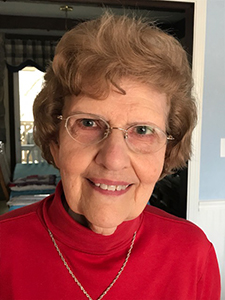

For as long as Rosalia remembers, the love of reading and learning have been important to her. “When I was in third grade, I read every book in the third grade library,” she recalls, amused. “I’ve been a reader from a long way back. I’ve always joked if I couldn’t find anything to read, I would read the labels on the soup can.”
This love of learning led Rosalia to become a home economics teacher and she also was certified to teach English. It was while teaching she met her husband.
When the hereditary disease Fuchs’ dystrophy threatened Rosalia’s ability to see clearly in retirement, she received two corneal transplants in the span of two years thanks to the generous gift of sight from eye donors. “I just feel so fortunate and blessed because this changed my life so completely,” she says. “I can’t express how grateful I am to the donors for my gift of sight.”
Rosalia is no stranger to Fuchs’ dystrophy and cornea transplantation. Her father underwent two full corneal transplants and her sister has also received two transplants so she knew what to expect. “You don’t just wake up one morning and everything is so cloudy you can’t see,” she says, “But it’s gradual and you try to compensate as long as possible.” As her eyesight diminished, Rosalia began having to read and sew using hand held magnifying glasses they kept in every room in their home. She also was the main driver in the family at the time and needed her vision corrected to be able to continue taking her husband to his dialysis appointments.
Thanks to her transplants, Rosalia can see clearly in her daily activities and while spending time with her 3 children and 5 grandchildren. “It is so wonderful that now I can pick up almost anything and read the fine print. It’s such a blessing.”
Rosalia has long carried the organ donor designation on the back of her driver’s license and encourages others to join the registry as well. “I strongly felt that was important, and having had a parent who had been through it I understand it even more,” she says. “When you no longer need it, if someone else can see or receive a heart, lung or kidney why not donate to help them? Because of my husband’s need for dialysis, I know how long the list is for getting a kidney, so I felt very blessed to be able to receive a cornea transplant,” says Rosalia.
You can help others when you join the national organ, eye and tissue donor registry at www.registerme.org. And be sure to discuss your decision with family members so they know what your wishes are regarding donation.
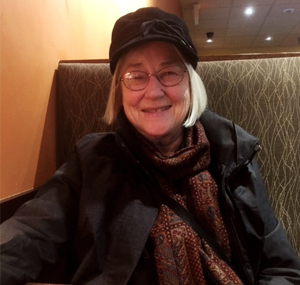

Thanks to the gift of sight, Anita was able to receive a corneal transplant in hopes of restoring her vision.
Not long ago, diminishing sight threatened to take away Anita’s ability to read and see well enough to sew her quilts. An active and proud grandmother, she and her husband recently retired to Columbia to be closer to their children and grandchildren. “We are loving being close enough to be part of their lives as they are growing up,” says Anita. Though they now live in mid-Missouri, Anita is a proud Vermonter through and through and they enjoy going back to visit every summer.
Anita’s journey with sight started with a cataract operation that did not have the outcome of clearing her vision. Since the cataract surgery, she has had 3 corneal transplants in hopes of restoring her vision in her right eye. “My eye appears to have been damaged by a few bouts of Bell’s Palsy,” says Anita. “My eye wouldn’t blink and during that time most likely caused damage to my eye as it wasn’t closing properly. The eye wasn’t shutting and it might have dried out the bottom of the first transplant.”
Anita’s most recent corneal transplant is working well so far. “With this one they have closed my eye a little bit from the corner to help keep it a tight close so my eye won’t get dried out at night.” Anita has seen progress and her vision keeps getting better and better.
“Following my first surgery, I’ve had Dr. Fraunfelder. He’s been great and I’ve enjoyed working with him,” says Anita. Dr. Frederick Fraunfelder is the director of University of Missouri Health Care’s Mason Eye Institute and chair of the Department of Ophthalmology at the MU School of Medicine.
Sending Thanks through Correspondence
Anita chose to write a letter to her donor family through Saving Sight’s Correspondence Program. “If someone in my family became an eye or organ donor I would be most appreciative to get a note from the recipient,” says Anita. “This generous decision that their loved one made resulted in my receiving a whole cornea transplant in a procedure aimed at restoring vision in my right eye. I thank them from the bottom of my heart. This generosity will never be forgotten.”
Anita is grateful to her donor family and is a registered organ, eye and tissue donor herself.
You can save and enhance lives when you join the national registry at registerme.org.
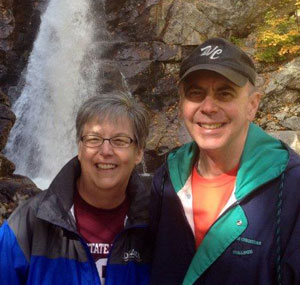

David and his wife Jennifer.
Working in higher education, David’s job requires him to do detailed, number calculations. Because of the generous gift of sight from three donors, David can continue his work. “It is vital that I am able to differentiate between 5’s & 6’s and 3‘s and 8’s,” said David. “Thank you for making it possible that I can continue to work and provide for my wife and me.”
David received his third corneal transplant in January 2017. “I have keratoconus where the cornea grows into the shape of a cone rather than being round,” said David. The disease distorts the vision until it eventually cannot be corrected with glasses or contacts. His most recent transplant was because keratoconus distorted the original transplant in his eye after 23 years. “I have had three cornea transplants. The first was very painful and uncomfortable. Though a ‘success,’ the result was not as satisfactory as hoped. The last two were much more comfortable and recovery was easier,” said David.
Several areas of David’s life have been enhanced because of his corneal transplants. He’s able to continue working, read, watch TV, drive, and watch his daughters graduate from college and begin their adult lives. David added that without the transplants, he would be functionally blind. “The most recent transplant has not healed enough to provide better vision; however, it should eventually. The previous transplants have enabled me to continue working with improved vision. I work primarily with numbers and print,” said David. “Without the transplants, I would not be able to work in my field of study and expertise because I would not be able to read without great difficulty.”
Because of the impact donation has made on his life, David chose to write to his donor family through Saving Sight’s Correspondence Program. “The donor’s family made a choice to provide the cornea during what was probably a very sad and painful time in their lives. It is important for the family to know that the choice made at that time provides sight and hope to another individual and family,” said David. “Hopefully this knowledge gives them some comfort.”
David encourages others to join the national registry as an eye, organ and tissue donor because of his experiences. “A person’s life can be extended, enriched and changed by a donation,” said David. “I would encourage people to donate organs of any kind, not just corneas. As gruesome as some people think that eye surgery may be, it is worth it and the results can enhance a person’s life and even be life-changing.”
Has eye donation touched your life as a donor family or recipeint family with Saving Sight?
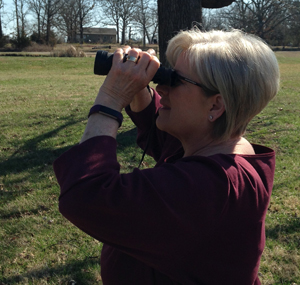

“As my vision becomes clearer and clearer I realize that I had forgotten how bright and colorful our world is and I appreciate and love every second of it,” said Pam.
Watching deer graze in the valley and geese land on her pond were just a few of the beautiful sights of nature Pam enjoys at her country home in Lebanon, Mo. Those sights mean more to Pam now than ever before after the hereditary eye disease Fuch’s dystrophy threatened to take her vision away.
“My vision kept getting dimmer and dimmer and glasses just didn’t fix it,” said Pam. “We realized through several tests that it was Fuch’s dystrophy.” As her vision deteriorated, Pam no longer felt safe driving her car because she couldn’t see road signs on the side of the road and was missing important details as she drove. She struggled with daily tasks, began missing out on some her favorite hobbies and even stayed home from family outings because she couldn’t see.

As an avid birdwatcher, Pam is able to see the fine details in feathers and coloring she was missing before her transplant.
As an avid birdwatcher, Pam is able to see the fine details in feathers and coloring she was missing before her transplant.In July of 2016, Pam received a successful cornea transplant at Mattax Neu Prater Surgery Center in Springfield thanks to the generosity of an eye donor. Pam chose to write to her donor family to thank them for their kindness. “Families have felt such a loss but they have helped other people,” said Pam. “I knew they had suffered a loss and just wanted them to know we appreciated the gift. It’s not just that the donor gave but the family accepted and followed through with their wishes.”
Today, Pam has regained her active lifestyle exploring the outdoors and gardening. She and her husband are avid birdwatchers and she is able to see the fine details in feathers and coloring she was missing before her transplant. Pam has regained her independence, driving with confidence again and seeing details when grocery shopping, watching television, reading menus in restaurants and even beading her holiday Christmas balls. More than anything, Pam is able to watch her 6 grandchildren play soccer and their other activities and see the world as they see it.
“As my vision becomes clearer and clearer I realize that I had forgotten how bright and colorful our world is and I appreciate and love every second of it,” said Pam.
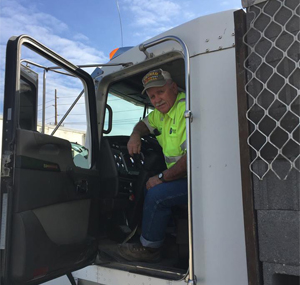

Thanks to the generosity of a donor and their family, Larry received the gift of sight through a corneal transplant in October 2015 to correct his vision and allow him to continue his occupation as a truck driver.
Imagine the murkiness and cloudiness of a pool that doesn’t have a filter. Try as you might, you can’t get a crisp glimpse of what’s underneath the surface. For Larry, the cloudiness in his eye was like that. Everything was getting cloudy and blurry, making it difficult to see. And, as a career truck driver, clear vision and a good bill of health are critical to the livelihood of Larry’s family.
Thanks to the generosity of a donor and their family, Larry received the gift of sight through a corneal transplant in October 2015 to correct his vision and allow him to continue his occupation as a truck driver. “I’m thankful their loved one chose to donate,” said Larry. “My doctor said it would get to where I lost my eyesight completely if I didn’t have the transplant.”
The tissue for Larry’s transplant was provided by Saving Sight and was successful in correcting Larry’s post-cataract surgery edema. Thirty-two years ago Larry had surgery to correct cataracts in both eyes. Recently he began having issues with the old implants and they were taken out and replaced. As is sometimes the case, one of the new cataract implants caused him to develop corneal edema. The cataract surgery caused abnormalities in the innermost layer of the cornea, causing fluid to stay on the cornea. This was causing the blurriness and cloudiness in his vision, which led to Larry needing a corneal transplant.
Prior to Larry’s transplant, he didn’t have a connection to donation and transplantation or know very much about the process. “I never knew that people donated things like that,” said Larry. “I registered as an organ donor after my cornea transplant.” He added that his successful transplant and the impact transplants can have in the lives of others is what motivated him to join the eye, organ and tissue registry. He also chose to support Saving Sight through a financial donation that will help others in receiving the gift of sight.
Larry has a few months of healing left before his doctor will determine his final corrective lens prescription, but his experience has been positive in improving his vision. “The experience is a process but I appreciate the cornea and being able to see. This helped fix my vision to keep driving,” said Larry.
Join Larry and countless others by registering your decision to an eye, organ and tissue donor at registerme.org and share your decision with your loved ones.
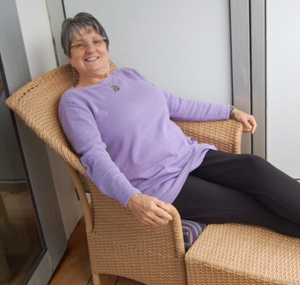
 Hiking over rough terrain and in cold temperatures is worth it to see the beauty of a glacier. On a recent Alaskan cruise from Anchorage to Vancouver, British Columbia, Katie and her husband hiked at Davidson Glacier in Alaska. “We had to hike over rough terrain to get to the glacier. There was a time I was not able to see well enough to hike with confidence. Now that I can see clearly, I feel able to take it on,” said Katie. “Every day I am grateful for my eyesight and the things I can accomplish.”
Hiking over rough terrain and in cold temperatures is worth it to see the beauty of a glacier. On a recent Alaskan cruise from Anchorage to Vancouver, British Columbia, Katie and her husband hiked at Davidson Glacier in Alaska. “We had to hike over rough terrain to get to the glacier. There was a time I was not able to see well enough to hike with confidence. Now that I can see clearly, I feel able to take it on,” said Katie. “Every day I am grateful for my eyesight and the things I can accomplish.”
Just 3 years ago, Katie’s eyesight had deteriorated due to the eye condition keratoconus, which causes the normally round cornea to bulge and become cone-shaped. The misshaped cornea causes nearsightedness and blurred vision. Katie knew someday she would have to have a corneal transplant due to the condition. The question wasn’t if, but rather when. An avid reader, she was no longer able to see the words on the pages of her favorite books and relied on audio books to enjoy her favorite titles. Katie and her husband enjoyed traveling, but unable to read signs in the airport and along roadways, Katie’s worsening vision limited their ability to travel to the places they wanted to go.

In October 2013, Saving Sight coordinated donation from a generous donor to give Katie the gift of sight through a corneal transplant. With regained sight, Katie couldn’t be more appreciative to the donor and their family. “There is always that sorrow of losing a loved one and I thank them for making this decision,” said Katie. “Organ donation is essential to enhance peoples’ lives, not just corneas but everything – you can save a life or improve a life immensely.” Katie joined the organ donor registry years ago in the state of Illinois and carries the designation on her driver’s license.
Katie advises others who need a corneal transplant to go ahead with the transplant and enjoy the benefits of restored sight. “Be patient with the healing process, but it’s worth it,” she said. “I appreciate what Saving Sight does and being able to see better now.”
Join Katie and countless others by registering your decision to an eye, organ and tissue donor at registerme.org and share your decision with your loved ones.